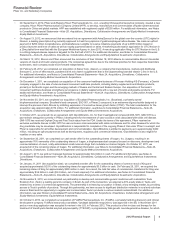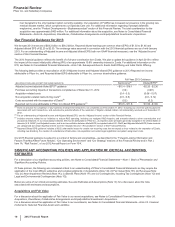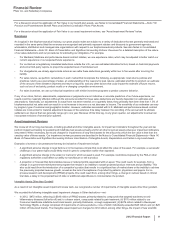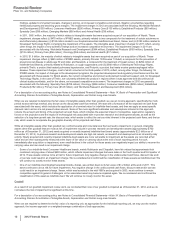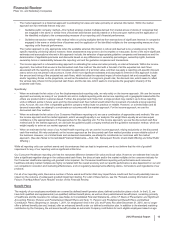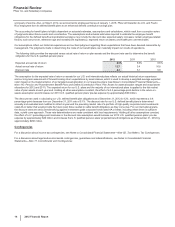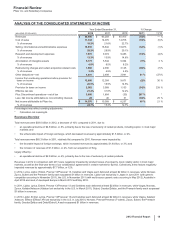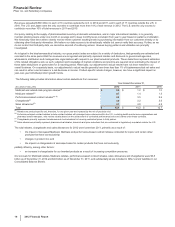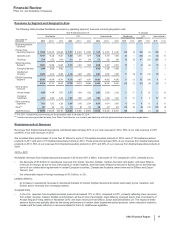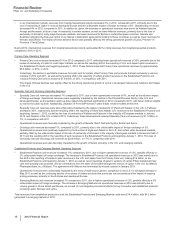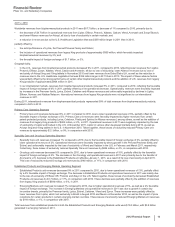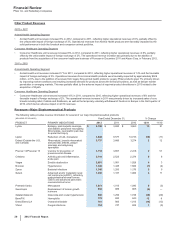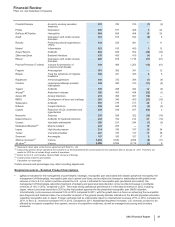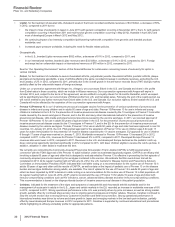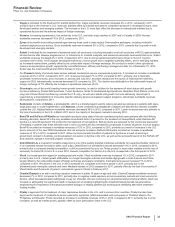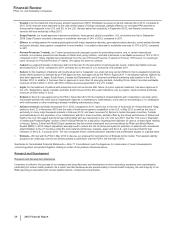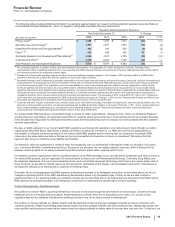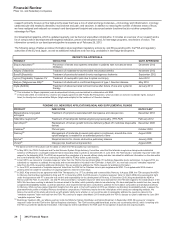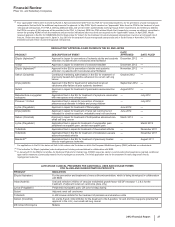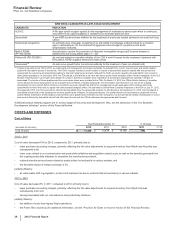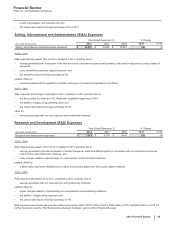Pfizer 2012 Annual Report Download - page 20
Download and view the complete annual report
Please find page 20 of the 2012 Pfizer annual report below. You can navigate through the pages in the report by either clicking on the pages listed below, or by using the keyword search tool below to find specific information within the annual report.
Financial Review
Pfizer Inc. and Subsidiary Companies
2012 Financial Report
19
2011 v. 2010
Worldwide revenues from biopharmaceutical products in 2011 were $57.7 billion, a decrease of 1% compared to 2010, primarily due to:
• the decrease of $4.7 billion in operational revenues from Lipitor, Effexor, Protonix, Xalatan, Caduet, Vfend, Aromasin and Zosyn/Tazocin,
and lower Alliance revenues for Aricept, all due to loss of exclusivity in certain markets; and
• a reduction in revenues due to the U.S. Healthcare Legislation that was $359 million larger in 2011 than in 2010,
partially offset by:
• the solid performance of Lyrica, the Prevnar/Prevenar family and Enbrel;
• the inclusion of operational revenues from legacy King products of approximately $950 million, which favorably impacted
biopharmaceutical revenues by 2%; and
• the favorable impact of foreign exchange of $1.7 billion, or 3%.
Geographically,
• in the U.S., revenues from biopharmaceutical products decreased 9% in 2011, compared to 2010, reflecting lower revenues from Lipitor,
Protonix, Effexor, Zosyn, Xalatan, Vfend, Caduet and Aromasin, all due to loss of exclusivity, lower Alliance revenues due to loss of
exclusivity of Aricept 5mg and 10mg tablets in November 2010 and lower revenues from Detrol/Detrol LA, as well as the reduction in
revenues due to the U.S. Healthcare Legislation that was $359 million larger in 2011 than in 2010. The impact of these adverse factors
was partially offset by the strong performance of certain other biopharmaceutical products and the addition of U.S. revenues from legacy
King products of approximately $904 million in 2011.
• in our international markets, revenues from biopharmaceutical products increased 5% in 2011, compared to 2010, reflecting the favorable
impact of foreign exchange of 6% in 2011, partially offset by a net operational decrease. Operationally, revenues were favorably impacted
by increases in the Prevenar family, Lyrica, Enbrel, Celebrex and Alliance revenues and unfavorably impacted by declines in Lipitor,
Effexor, Norvasc and Xalatan/Xalacom. International revenues from legacy King products were not significant to our international
revenues in 2011.
During 2011, international revenues from biopharmaceutical products represented 59% of total revenues from biopharmaceutical products,
compared to 56% in 2010.
Primary Care Operating Segment
• Primary Care unit revenues decreased 3% in 2011 compared to 2010, due to lower operational revenues of 6%, partially offset by the
favorable impact of foreign exchange of 3%. Primary Care unit revenues were favorably impacted by higher revenues from certain
patent-protected products, including Lyrica, Celebrex, Pristiq and Spiriva (in Alliance revenues), among others, as well as the addition of
revenues from legacy King products of $404 million, or 2%, in 2011. Operational revenues in 2011 were negatively impacted by the loss
of exclusivity of Lipitor and Caduet in the U.S. in November 2011, Lipitor in various other developed markets during 2010, as well as
Aricept 5mg and 10mg tablets in the U.S. in November 2010. Taken together, these losses of exclusivity reduced Primary Care unit
revenues by approximately $2.1 billion, or 9%, in comparison with 2010.
Specialty Care and Oncology Operating Segment
• Specialty Care unit revenues increased 1% compared to 2010, due to the favorable impact of foreign exchange of 3%, partially offset by
lower operational revenues of 2%. Operational revenues were favorably impacted by strong growth in the Prevnar/Prevenar family and
Enbrel, and unfavorably impacted by the loss of exclusivity of Vfend and Xalatan in the U.S. in February and March 2011, respectively.
Collectively, these losses of exclusivity reduced Specialty Care unit revenues by $624 million, or 4%, in comparison with 2010.
• Oncology unit revenues decreased 6% compared to 2010, due to lower operational revenues of 10%, partially offset by the favorable
impact of foreign exchange of 4%. The decrease in the Oncology unit operational revenues in 2011 was primarily due to the transfer of
Aromasin’s U.S. business to the Established Products unit effective January 1, 2011, as a result of its loss of exclusivity in April 2011.
This loss of exclusivity reduced Oncology unit revenues by $160 million, or 11%, in comparison with 2010.
Established Products and Emerging Markets Operating Segment
• Established Products unit revenues decreased 9% in 2011 compared to 2010, due to lower operational revenues of 13%, partially offset
by a 4% favorable impact of foreign exchange. The decrease in Established Products unit operational revenues in 2011 was mainly due
to the loss of exclusivity of Effexor XR, Protonix and Zosyn in the U.S. Taken together, these losses of exclusivity decreased Established
Products unit revenues by $1.7 billion, or 17%, in comparison with 2010. These declines were partially offset by the addition of revenues
from legacy King products of $546 million, or 5%, in 2011.
• Emerging Markets unit revenues increased 7% compared to 2010, due to higher operational revenues of 5%, as well as a 2% favorable
impact of foreign exchange. The increase in Emerging Markets unit operational revenues in 2011 was due to growth in certain key
innovative brands, primarily the Prevenar family, Lyrica, Enbrel, Celebrex, Vfend and Zyvox. These increases were partially offset by
lower revenues from Lipitor, which lost exclusivity in Brazil in August 2010 and Mexico in December 2010, as well as the impact of price
reductions for certain products in certain emerging market countries. These losses of exclusivity reduced Emerging Market unit revenues
by $118 million, or 1%, in comparison with 2010.
Total revenues from established products in both the Established Products and Emerging Markets units were $13.0 billion, with $3.8 billion
generated in emerging markets in 2011.


